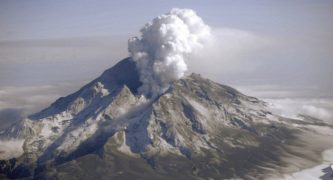
While scientists have long been able to predict the eruptions of volcanoes days in advance as they begin to smoke and rumble, researchers at NASA’s Jet Propulsion Laboratory, along with colleagues in Alaska, are using satellite data in an effort to predict eruptions months or even years ahead of time, according to JPL.
Accurately predicting volcanic eruptions well in advance has proved “notoriously hard” for scientists, JPL said in a written statement.
“This is, in part, because no two volcanoes behave in exactly the same way and because few of the world’s 1,500 or so active volcanoes have monitoring systems in place,” according to the statement. “Under the best of circumstances, scientists can accurately forecast an eruption of a monitored volcano several days before it happens.”
But new findings by a team of researchers from JPL and the University of Alaska, Fairbanks published last month in the journal Nature Geoscience may lead to breakthroughs, making use of data collected from orbiting satellites to improve predictions, explained lead study author Társilo Girona, formerly of JPL and currently working with the University of Alaska.
“The new methodology is based on a subtle but significant increase in heat emissions over large areas of a volcano in the years leading up to its eruption,” said lead author Társilo Girona, formerly of JPL and now with the University of Alaska, Fairbanks. “It allows us to see that a volcano has reawakened, often well before any of the other signs have appeared.”
The team analyzed more than 16 years worth of data tracking radiant heat emanating from volcanoes, making use of readings collected by NASA’s Terra and Aqua satellites, according to JPL.
“Despite the differences between the volcanoes, the results were uniform: In the years leading up to an eruption, the radiant surface temperature over much of the volcano increased by around 1 degree Celsius from its normal state. It decreased after each eruption,” the statement said.
Study co-author Paul Lundgren of JPL said the heat signatures were more than mere “hotspots, but rather, the warming of large areas of the volcanoes.”
“So it is likely related to fundamental processes happening at depth,” he said.
One hypothesis is that the heat stems from interactions between magma and hydrothermal systems underground, the JPL statement added. But there is much more to be learned.
“Volcanoes are like a box of mixed chocolates: They may look similar, but inside there is a lot of variety between them and, sometimes, even within the same one,” Lundgren said. “On top of that, only a few volcanoes are well monitored, and some of the most potentially hazardous volcanoes are the least frequently eruptive, which means you can’t rely strictly on historical records.”
With time and additional research, the findings could usher in new technologies to help better predict when volcanoes are preparing to blow their tops, Girona said.
“One of the goals is to one day have a tool that can be used in near real-time to check for volcanic activity in volcanic areas,” he said. “Even for small eruptions, there is evidence of thermal unrest before the initiation of the eruption event, so the new method helps bring us a little closer to that goal.”
The study can be found online at nature.com/articles/s41561-021-00705-4.














 0 comments
0 comments


